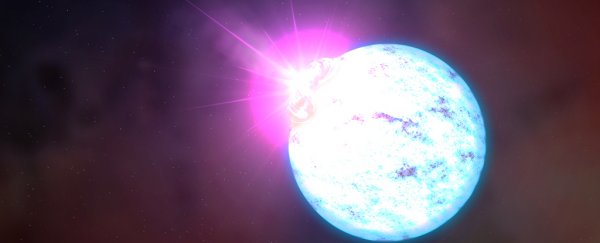Black holes are generally objects we associate with the collapse of massive stars, but researchers have debated whether they could have also formed in the instant after the Big Bang, long before the first sun fired up.
New research adds weight to the argument that black holes appeared less than a second after time began, and these primordial bodies might help answer the question on where many of the elements heavier than iron came from.
Physicists from the University of California in Los Angeles (UCLA) recently formulated a pair of hypotheses related to the formation and behaviour of what are called primordial black holes.
Unlike the black holes we get when a massive star runs out of fuel and falls into a singularity under its own gravity, these kinds of dense bodies are speculated to have popped into existence shortly after the Universe started to expand.
Immediately after the Big Bang, when the Universe was tiny and packed full of energy, everything was more or less evenly spread out.
With a rapid expansion some areas some areas might have clumped more than others, creating denser pockets of energy that would collapse under gravity to form a black hole.
That's the idea, anyway, but not all physicists are convinced by the reasoning, especially with empirical evidence hard to come by.
That hasn't stopped researchers from looking at the light echo of the Cosmic Background Radiation for signs of such clumping, though.
With these primordial black holes being contenders for the Universe's mysterious dark matter, the search is an important one in astrophysics.
Several months back, UCLA researchers published a report detailing a general model of how primordial black holes could form from a theoretical concentration of energy within a field called a Q-ball.
Importantly, the physicists claim their scenario doesn't rely on the same kinds of "unlikely coincidences" that give rise to doubt in other pictures, and suggests ways relics these ancient objects could still be observed by measuring changes in a star's brightness as they pass in front.
More recently UCLA researchers described what might happen should one of these primordial black holes meet a neutron star.
According to the physicists, the black hole would sink into the core of the super dense star and basically start to devour it from the inside, pulling in matter and growing in size.
Over a period of about 10,000 years the neutron star would shrink, spinning faster and faster.
Like cake batter flying from a mixer, bits of neutron-rich atomic material would be accelerated fast enough to escape the gravitational pull of the star and be flung out into the Universe.
It's in these star fragments that have been ejected by a parasitic black hole that neutron-rich heavy elements such as gold and uranium came from.
Check out the image below to see what this process looks like.
 Alexander Kusenko/UCLA
Alexander Kusenko/UCLA
The prevalence of these elements is currently something of a mystery.
"Scientists know that these heavy elements exist, but they're not sure where these elements are being formed," says UCLA researcher Alexander Kusenko.
"This has been really embarrassing."
It's understood that these often radioactive elements are made through rapid neutron capture process, or r-process for short.
The dilemma is that for these bulky elements to grow, they need to pick up neutrons faster than they can decay, something that has led researchers to look to neutron stars as a source.
The collapsing cores of stars that then explode into supernovae could spread elements produced as a result of r-process, but getting a model to match observations has been rather challenging.
Kusenko and his team think primordial black holes coming into contact with neutron stars would solve some of those problems.
Since such meetings would be incredibly rare, it could explain why some galaxies are richer in heavy elements than others.
The researchers now plan to collaborate with other research teams to run computer simulations on the interactions and see if they explain whether such parasitic unions are indeed responsible for bigger, heavier elements making up our planet.
This research was published in Physical Review Letters here and here.
